

Shadow Puppet Play - China culture. The shadow puppet play, also called "shadow play", is a drama form in which the player holds the human figures that are engraved by the animal hides with colored paintings, and reflected on the curtain through the light, singing and dancing controlled by the player with the silk string, gongs and drums music, playing a series of stories.
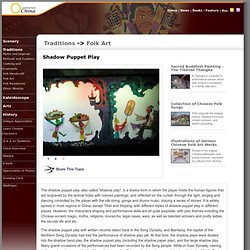
It is widely spread in most regions in China, except Tibet and Xinjiang, with different styles of shadow puppet play in different places. However, the characters shaping and performance skills are all quite exquisite, with play themes including the Chinese ancient magic, myths, religions, monarchs, legal cases, wars, as well as talented scholars and pretty ladies, the secular life and etc. The shadow puppet play with written records dated back to the Song Dynasty, and Bianliang, the capital of the Northern Song Dynasty had had the performance of shadow play yet. What Are Shadow Puppets? Have you ever used just your hand, a light and a wall to make a shadow figure?
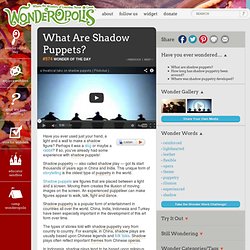
Perhaps it was a dog or maybe a rabbit? If so, you’ve already had some experience with shadow puppets! Shadow puppetry — also called shadow play — got its start thousands of years ago in China and India. This unique form of storytelling is the oldest type of puppetry in the world. Shadow puppets are figures that are placed between a light and a screen. Shadow puppetry is a popular form of entertainment in countries all over the world. The types of stories told with shadow puppetry vary from country to country. In Indonesia, shadow plays tend to be based upon religious stories of good vs. evil. The first shadow puppets were likely made out of animal hides. Shadow puppets can be made from a wide variety of materials, though. Shadow puppets are usually constructed in separate pieces that are then put together with strings or wires. Oregon Shadow Theatre: What is Shadow Puppetry?
Shadow puppetry is considered the oldest form of puppetry in the world.
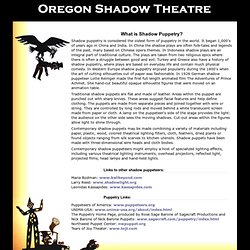
It began 1,000's of years ago in China and India. In China the shadow plays are often folk-tales and legends of the past, many based on Chinese opera themes. In Indonesia shadow plays are an integral part of traditional culture. The plays are taken from two religious epics where there is often a struggle between good and evil. Playing with Shadows: Kennedy Center Interactive.
Chinese Shadow Puppetry. Arts Online Shadow Puppetry. Back to home | Back to 'Teaching sequence' Wayang kulit The Indonesian word 'wayang' is derived from a word meaning 'shadow' or 'ghost'.
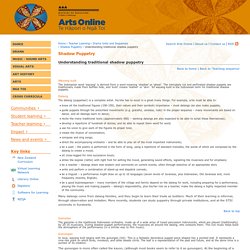
The intricately cut and perforated shadow puppets are traditionally made from buffalo hide, and 'kulit' means 'leather' or 'skin'. So wayang kulit is the Indonesian term for traditional shadow puppets. Dalang The dalang (puppeteer) is a complete artist. Many dalangs come from dalang families, and they begin to learn their trade as toddlers. Back to top Gamelan The gamelan is the traditional Indonesian orchestra, made up of a wide array of tuned percussion instruments, which are played (traditionally) by 20–25 musicians. Gunungan In Java, wayang kulit begins with the gunungan (hill).
The gunungan is more often called the kayon, (although most books seem to refer to it as gunungan). A second gunungan has already been placed as the left marker. During the performance the gunungans are used to represent scenery elements, particularly forest and clouds. You Tube Shadow Puppet Videos. Uncopyrighted Shadow Puppet Google Images. Tag Galaxy - type in "shadow puppet" and watch what happens! Myths & Legends Te Ara. Myths & Legends Public Domain Review. Myths & Legends Matapihi. Myths & Legends Many Answers. Myths & Legends Natlib. Image by Don Stewart Aaron’s world of stories Here is a wide selection of folktales, fairy tales, tall tales, myths, legends, magical tales, and sacred stories, plus original fables, humor, and historical fiction.

Also included are resources for storytelling, and an online guide to telling stories. Suggested level: primary, intermediatewww.aaronshep.com/stories/folk.html Folk legends of Japan Read the stories from "once upon a time in Japan. " Suggested level: Māori Myths & Legends TKI. Kia ora and welcome to Māori Myths, Legends and Contemporary Stories.
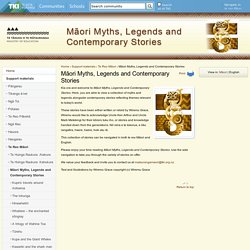
Here, you are able to view a collection of myths and legends alongside contemporary stories reflecting themes relevant to today's world. These stories have been either written or retold by Wiremu Grace. Wiremu would like to acknowledge Uncle Ken Arthur and Uncle Mark Metekingi for their kōrero tuku iho, or stories and knowledge handed down from the generations. Nō reira e te tokorua, e ōku rangatira, haere, haere, hoki atu rā.
This collection of stories can be navigated in both te reo Māori and English. Please enjoy your time reading Māori Myths, Legends and Contemporary Stories. We value your feedback and invite you to contact us at mataurangamaori@tki.org.nz. Text and illustrations by Wiremu Grace copyright (c) Wiremu Grace Return to top.